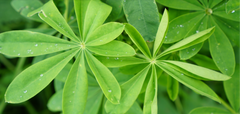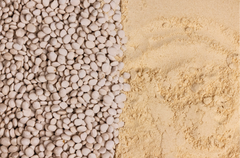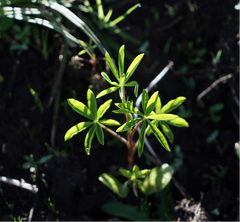
Chocho 101 | Regenerative Plant Protein
High in the middle of the Ecuadorian Andes lie a multitude of volcanoes like Cotopaxi, Antisana, Chimborazo, Sangay, El Guagua, and El Reventador. These are names that ‘peak’ the ears of climbers and mountaineers around the world as they are some of the toughest and most beautiful climbs in the Andes Sierras. These mountains can reach up to 20,000ft (Chimborazo and Cotopaxi) and are part of what we call in Ecuador ‘Volcano Alley’.
Ecuador is a country of great exploration, people and food. In the middle of Volcano Alley lies one of the most beautiful crops, its seeds are richer in protein than peas, hemp, soy, and peanuts. This Andean crop is one of the world’s premier plant protein sources, and it’s called Chocho (1). Chocho, is a traditional crop from Ecuador and the Andes that has been cultivated at least for 2,500 years.
 Volcano Alley. Sangay. Photo: Kevin Moncayo.
Volcano Alley. Sangay. Photo: Kevin Moncayo.
Chocho is a regenerative crop with the highest protein content out of all plant proteins, chocho has gained importance due to its widely appreciated nutritional value. This pearly-white super bean is outstandingly nutritious, with outstanding protein, fiber and mineral content (1). What is unique about Chocho’s composition is that each bean is made up of 52-58% protein, and its building blocks construct a complete amino acid profile. Chocho features a complete amino acid profile and is specifically high in amino acids leucine, lysine and valine (Branch Chained Amino Acids aka BCAAs).
So why haven't we heard of Chocho before? Chocho need to be processed before their consumption because of the presence of alkaloids, which are chemicals that protect the plant against insect attacks. Chochos are grown by small farmers in the Ecuadorian Andes, they are then dried and stored for their commercialization. Stigmatized ‘as poor people's food’ chocho cultivars have not gained much attention. But there is history behind this crop and has been used by Andean cultures for at least 2000 years.
One of the earliest records that we have of Chocho being used is from the Tiwanaku culture, who were present in the Andes before the Incas 1000-1200 B.C. The Tiwanaku used Chocho seeds along Kaniwa (Canihua) and Kichiwa (Amaranth) for food storage because of their long ‘shelf-life’ capability (Bowman 1981). A theory is that Tiwanaku was the first culture in testing how Chocho, Amaranth and Quinoa work but further research is required (Bowman 1981) (Tello 1976). In more recent times, Chocho was used by the Caranquis, an Incan subculture that resided in the northern part of Ecuador among the valleys of Otavalo, Cayambe and Ibarra 500 A.C. When the Spanish arrived Chocho was accounted for as a staple crop of the ‘Indians’ in the early 17th century (Rodriguez Docampo 1965) and described as that it was cultivated similarly to wheat with the same collection and processes. In modern times Chocho has not been used as a crop for consumption, lost its popularity and it is stigmatized as ‘poor people's food’. It is mostly used as an aid to farmers to co-plant and improve the quality of other crops like corn, potatoes and vegetables as its roots also improve soil quality through nitrogen fixation assisting the adjacent crops for optimal growth (1).
So how does Chocho grow and how did these people eat it? Chocho fields are growing strong in June and July where hundreds of thousands of flowers are on display before the vines start growing as Southern Hemisphere Winter starts to kick. At the peak months of Winter, Chocho vines start to grow to about 4-6ft tall. Each vine contains from 4 to 10 seeds per pod. As the winter is in full force in September, these vines dry up and eventually fall into the ground. After winter ends and we approach a new summer, farmers gather up and collect the fallen vines, open them and start collecting the Chocho harvest for the year. We found out that Chocho grows better in the Equator (cite). The reason for this is because the plant mutates according to its environment, therefore its scientific name (lupinus mutabilis). After years of research, our theory is that it grows at higher altitudes where it doesn't freeze and is closer to the sun. Chocho plants love sunlight and this makes Ecuador Chocho’s favorite home. Not to mention Volcano Alley is where the air and its volcanic soil quality is some of the world’s most pure and fertile. Chocho plants are solely watered with rainwater as they are drought tolerant having increased outputs in drought conditions (1).

So what is the future of Chocho? This is why we specialized in the crop and Mikuna is has brought it to the US, in the face of an emerging plant market and earth crisis,where conscious consumers are being Punk-Rock about their diet, Chocho is a great alternative to conventional sources of protein. We could use Chocho to elaborate so many products from Tofu, Vegan Cheese and even Vegan meat. The possibilities are endless and we are excited to explore all the possibilities.
Our motivations behind Chocho? As deforestation is severely affecting the Amazon Rainforest and one of the primary causes of deforestation is protein production primarily from Cattle and soybeans (Cite). Moving protein to somewhere sustainable where the output weight. This is a reason why we have partnered up with the Rainforest Alliance to be the first Chocho farm certified by the Rainforest Alliance. As we have a long history farming in Ecuador and at the bottom of the Andes, our goal is to make a significant impact on the families and communities that are very isolated and have extreme poverty. We find Chocho as a tool and opportunity for them to be able to grow this magnificent crop and provide for their families. We at Mikuna have contracted over 100 small farming families to work with us and give us Chocho by the end of the year. We are happy to be vessels of this journey and bring you one step closer to higher nutrition and have the opportunity by choosing Chocho you are doing the most good for your body and the planet.
NOTES:
Leucine supports the repair of muscle tissue, skin, and bones, while lysine helps in building collagen and guarantees adequate calcium absorption. Valine is essential for the muscular metabolism and encourages mental vigor (Ha and Zemel, 2003). Chocho is a low glycemic index food (low GI), which is also linked to improvement in blood glucose (2). The shell of chocho is high in fiber and its predominant mineral is Calcium (Ca) with one serving of chocho having as much calcium as a glass of milk.
REFERENCES:
1) Lost Crops of the Incas: Little-Known Plants of the Andes with Promise for Worldwide Cultivation (1989)
2) Hypoglycemic effect of lupinus mutabilis in healthy volunteers and subjects with dysglycemia - https://pdfs.semanticscholar.org/aa08/88fb0b2f2daf78e3c8f0abbae2e3660fd9e2.pdf
Back to Journal



